Digital Poster Session
Acquisition, Reconstruction & Analysis: RF, Encoding, and Sampling & Application of Nascent Acquisitions
Acquisition, Reconstruction & Analysis
3689 -3704 RF, Encoding, and Sampling & Application of Nascent Acquisitions - RF Pulses & Pulse Sequences
3705 -3719 RF, Encoding, and Sampling & Application of Nascent Acquisitions - Applications of Nascent Acquisition Methods
3720 -3735 RF, Encoding, and Sampling & Application of Nascent Acquisitions - Data Sampling & Spatial Encoding Techniques
3689.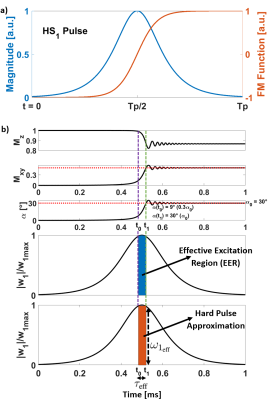 |
Optimal Flip Angle Formula for SWIFT and CEA (Concurrent Excitation and Acquisition) MRI
Serhat Ilbey1, Michael Garwood2, Michael Bock1, and Ali Caglar Özen1,3
1Dept. of Radiology, Medical Physics, Medical Center – University of Freiburg, Freiburg, Germany, 2Center for Magnetic Resonance Research and Department of Radiology, University of Minnesota, Minneapolis, MN, United States, 3German Consortium for Translational Cancer Research Partner Site Freiburg, German Cancer Research Center (DKFZ), Heidelberg, Germany
MR imaging of tissue components with extremely fast transverse relaxation times require advanced MRI techniques such as continuous SWIFT (cSWIFT), Concurrent Excitation and Acquisition (CEA), and full duplex MRI. Frequency modulated pulses are used in these methods. A steady-state signal model with transverse relaxation term was formulated and solved for an arbitrary frequency and phase modulated RF pulse. An accurate expression for the optimal flip angle was derived. The performance of the new formulation was verified by a home-made Bloch equation simulator for T2 values between 10µs and 100ms.
|
|
3690.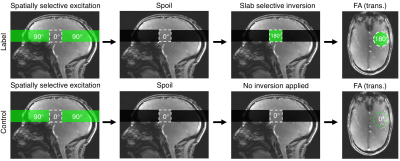 |
Mapping oxygen extraction fraction using a tailored parallel transmission RF pulse at 7 T
Yan Tong1, Peter Jezzard1, Caitlin O'Brien1, and William T Clarke1
1Wellcome Centre for Integrative Neuroimaging, FMRIB Division, NDCN, University of Oxford, Oxford, United Kingdom
T2‐relaxation under‐spin‐tagging (TRUST) is a robust spin tagging based method to quantify oxygen extraction fraction (OEF), but it lacks spatial specificity. Recently O’Brien et al. proposed a method involving multiple saturation pulses to achieve spatial specificity. Parallel transmission (pTx) provides additional degrees of freedom for spatial localisation. A pTx RF pulse design strategy based on a shells trajectory is applied to perform regional OEF measurement at 7 T. Initial in-vivo results acquired from one healthy subject showed that spatial localisation of OEF could be achieved.
|
|
3691.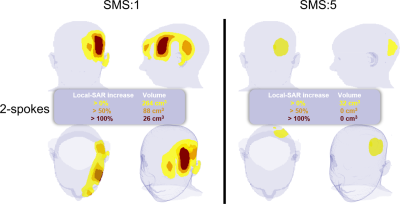 |
Simultaneous multi-slice imaging reduces sensitivity of local-SAR to patient motion at 7T
Emre Kopanoglu1, Cem M. Deniz2, and Richard G. Wise1,3
1CUBRIC, School of Psychology, Cardiff University, Cardiff, United Kingdom, 2Department of Radiology, New York University Langone Health, New York, NY, United States, 3Institute for Advanced Biomedical Technologies, University of Chieti-Pescara, Chieti, Italy
This study investigates the effect of within-scan patient motion on local-SAR for simultaneous multi-slice (SMS) imaging at 7T. A virtual body model was simulated at 104 different positions. 1-/2-/3-spokes pulses were designed to excite a region of 60 slices covering the cerebellum and the brain, using SMS-factors of 1 through 5. Local-SAR was observed to increase by up to 2.75-fold due to patient motion. Pulses with higher SMS-factors were up to 50% less sensitive against changes in local-SAR due to patient motion, compared to SMS:1 pulses. Pulses with higher SMS-factors yielded more consistent local-SAR throughout the scan.
|
|
3692.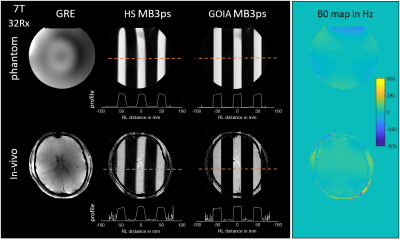 |
Designing B0 robust adiabatic multi-band inversion pulses with high time-bandwidth products and smooth slice selective gradients
Christoph Stefan Aigner1 and Sebastian Schmitter1
1Physikalisch-Technische Bundesanstalt (PTB), Braunschweig and Berlin, Germany
We demonstrate the design of adiabatic multi-band inversion pulses with high time-bandwidth products and acceptable RF power demands. The proposed utilization of GOIA single-band pulses results in smooth slice selective gradients with highly reduced RF power and matched multi-band RF waveforms. Phantom and in vivo experiments at 3T and 7T validate the simulations and demonstrate robust inversion of multiple slices over a wide range of both B1+ and B0 values.
|
|
3693.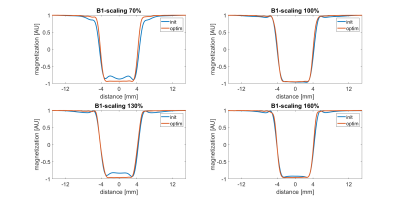 |
Inversion Pulses with B1-Robustness and Reduced Energy by Optimal Control
Christina Graf1, Christoph Stefan Aigner2, Armin Rund3, Andreas Johann Lesch1, and Rudolf Stollberger1
1Institute of Medical Engineering, Graz University of Technology, Graz, Austria, 2Physikalisch-Technische Bundesanstalt (PTB), Braunschweig and Berlin, Germany, 3Institute of Mathematics and Scientific Computing, University of Graz, Graz, Austria
The aim of this work is to design slice-selective inversion RF pulses that are robust among $$$B1$$$-variations while the pulse energy is reduced. For that purpose, an optimal control framework based on an ensemble formulation is introduced. The numerically optimized RF pulses showed an excellent performance compared to the target magnetization for a broad range of $$$B1$$$-scalings. Phantom measurements were performed using a 32 channel head coil for receive and a birdcage body coil for transmit and revealed excellent inversion profiles.
|
|
3694.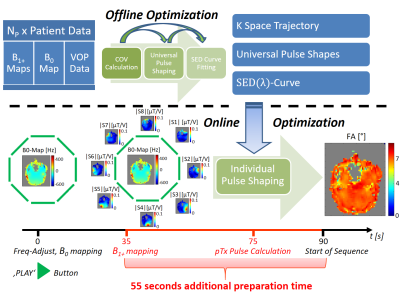 |
Fully embedded parallel transmission: Stable performances using universal pulses with fast online customization
Jürgen Herrler1, Patrick Liebig2, Rene Gumbrecht2, Manuel Schmidt1, Michael Uder3, Andreas Maier4, Arnd Dörfler1, and Armin Nagel3,5
1Institute of Neuroradiology, University Hospital Erlangen, Erlangen, Germany, 2SIEMENS Healthineers, Erlangen, Germany, 3Institute of Radiology, University Hospital Erlangen, Erlangen, Germany, 4Friedrich Alexander University Erlangen Nürnberg, Erlangen, Germany, 5Institute of Medical Physics, Friedrich Alexander University Erlangen Nürnberg, Erlangen, Germany To homogenize signals 7 Tesla MRI reliably and fast, a pTx pulse design process was established. Trajectory, energy regularisation parameter and universal pulse shapes were calculated by solving global optimization problems using a dataset of 12 subjects (B1+ profiles, B0, VOP). Pulse shaping is done online using the actual subject‘s data acquired during the sequence preparation phase which lasts about 90s. A fitting curve for SED is also provided which, combined with online calculated SED values, aims to use the full amount of tolerable SAR. Compared with the CP-Mode, the NRMSE could be substantially improved for all 36 volunteers. |
|
3695.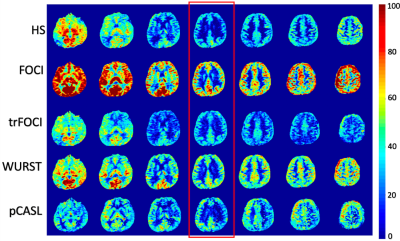 |
Optimization of adiabatic pulses for Pulsed ASL at 7T – Comparison with Pseudo-continuous ASL
Kai Wang1, Xingfeng shao1, Lirong Yan1, Jin Jin1,2,3, and Danny Wang1
1Laboratory of FMRI Technology (LOFT), Mark & Mary Stevens Neuroimaging and Informatics Institute, Keck School of Medicine, University of Southern California (USC), Los Angeles, CA, United States, 2School of Information Technology and Electrical Engineering, The University of Queensland,, Brisbane, Australia, 3ARC Training Centre for Innovation in Biomedical Imaging Technology, The University of Queensland, Brisbane, Australia
The goal of this work was to optimize and evaluate four types of adiabatic pulses for pulsed ASL (PASL) at 7T including Hyperbolic Secant (HS), WURST, FOCI and trFOCI pulses using theoretical simulation, phantom and in vivo scans, and compare them with pseudo-continuous ASL (pCASL). PASL with WURST pulse outperformed PASL with HS, FOCI and trFOCI in terms of labeling efficiency and residual signal, and also showed higher labeling efficiency compared with pCASL, and thus is recommended for 7T perfusion measurement.
|
|
3696.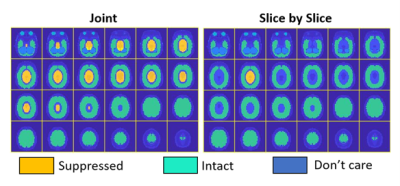 |
Tailored 3D Inner Volume Suppression Pulses for MR Corticography
Jun Ma1, Xinqiang Yan2, Bernhard Gruber3, Jonathan Martin1, Zhipeng Cao2, Jason Stockmann3, Kawin Setsompop3, and William Grissom1
1Biomedical Engineering, Vanderbilt University, Nashville, TN, United States, 2Department of Radiology and Radiological Sciences, Vanderbilt University Medical Center, Nashville, TN, United States, 3Athinoula A. Martinos Center for Biomedical Imaging, Massachusetts General Hospital, Charlestown, MA, United States
To fully utilize the potential of a new cortical imaging-optimized 7T scanner with Gmax= 200 mT/m & Smax=700 T/m/s gradients, 128 Rx channels, 16 Tx channels, and an AC/DC B0 shim array, we describe a tailored parallel transmit inner-volume-suppression (IVS) pulse design, which can enable highly accelerated functional and diffusion imaging by reducing g-factor and suppressing physiological noise from ventricle CSF. 3D IVS pulses were designed using simulated B1+ maps for the scanner’s 24-element coil. Simulation results demonstrated uniform inner volume suppression for 3D and 2D imaging. A 2D in-vivo IVS pulse design experiment demonstrated IVS’s ability to reduce g-factor.
|
|
3697. |
The Effects of Coupled B1 Fields in B1 Encoded TRASE MRI – A Simulation Study
Pallavi Bohidar1, Hongwei Sun2, Jonathan C. Sharp2, and Gordon E. Sarty1
1Division of Biomedical Engineering, University of Saskatchewan, Saskatoon, SK, Canada, 2Department of Oncology, University of Alberta, Edmonton, AB, Canada
Transmit Array Spatial Encoding (TRASE) is a novel MRI technique that achieves spatial encoding by introducing phase gradients in the transmit RF magnetic field (B1). In this study, Bloch simulations were performed to investigate and study the effects of B1 field perturbations arising from inductive coupling among RF coils for 2D TRASE imaging. Simulations show that a flip angle contribution of ~95% or higher from the primary (driven) transmit coil is required for 2D TRASE MRI. This result is of crucial importance for designers of practical TRASE transmit array systems.
|
|
3698. |
Motion Robust Parallel Transmission Excitation Pulse Design for Ultra-High Field MRI
Luke Watkins1, Alix Plumley1, Kevin Murphy1, and Emre Kopanoglu1
1Cardiff University Brain Research Imaging Centre, Cardiff, United Kingdom
Within-scan patient motion hampers the performance of parallel-transmit (pTx) pulses. In this study we developed a motion-robust pTx pulse (MRP) in the small tip angle regime to improve magnitude homogeneity over a range of pitch/roll/yaw rotations from 0° to 5°. The 4-spoke MRP was compared to a 3-spoke conventionally designed pulse (CDP). The MRP produced more homogenous magnitude profiles than the CDP for all evaluated rotations (0°,1°,2°,5° around each axis). The benefit of the method was more prominent with increased rotation angles. The proposed design shows potential for excitation pulses that maintain highly homogeneous magnitude profiles during patient head motion.
|
|
3699.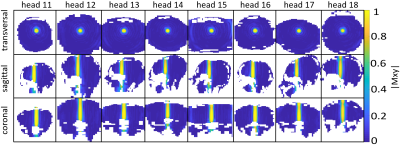 |
Universal Parallel Transmit Pulse Design for 3-D Local-Excitation based on different sized databases of B0/B1+-maps – A 7T Study
Ole Geldschläger1, Tingting Shao1, Jürgen Herrler2, Armin Nagel3,4, and Anke Henning1,5
1High-field Magnetic Resonance, Max-Planck-Institut for biolog. Cybernetics, Tübingen, Germany, 2Institute of Neuroradiology, University Hospital Erlangen, Erlangen, Germany, 3Institute of Radiology, University Hospital Erlangen, Erlangen, Germany, 4Institute of Medical Physics, Friedrich Alexander University Erlangen Nürnberg, Erlangen, Germany, 5Advanced Imaging Research Center, University of Texas Southwestern Medical Center, Dallas, TX, United States
This study investigates universal parallel-transmission (pTx) radio-frequency-pulses for 3-dimensional local-excitation designed on different sized databases of B0/B1+-maps from human heads at 7T. Thus, it prospectively abandons the need for time-consuming subject specific B0/B1+-mapping and pTx-pulse calculation during the scan session. For the proposed calculation routine, the design-database does not need to include more than five heads, to achieve a pTx-pulse that excites the same 3-dimensional local-excitation target-pattern on the tested 40 different heads. The resulting universal pulses created magnetization-profiles with (in most cases) an only marginally worse Normalized-Root-Mean-Square-Error compared to the magnetization-profiles produced by pulses tailored to individual heads.
|
|
3700.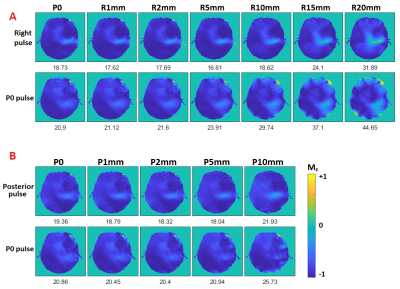 |
Large tip-angle, motion robust pulse design for parallel transmission at 7T using composite B1 distributions.
Alix Plumley1, Luke Watkins1, and Emre Kopanoglu1
1CUBRIC, School of Psychology, Cardiff University, Cardiff, United Kingdom
Parallel-transmit (pTx) pulses can help overcome B1 inhomogeneity at ultra-high field, however their performance is sensitive to geometry, orientation and composition of the coil load. Head motion in pTx effectively alters the load, damaging pulse performance and reintroducing artificial contrast to images. Here, we introduce a versatile method to reduce in-plane motion sensitivity of large tip-angle, parallel transmit pulses by designing pulses based on weighted-average B1-distributions. These include B1-distributions from multiple head positions to effectively expand the area over which the pulse can function. Error in resulting inversion profiles is reliably reduced following most in-plane translations and rotations, demonstrating motion-robustness.
|
|
3701.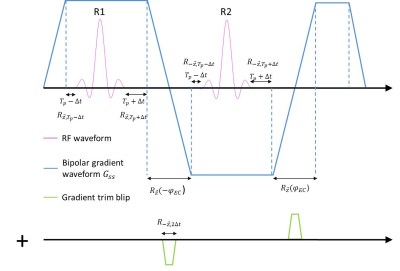 |
Sub-µs gradient delay correction in tilted slab-selective bipolar multi-spoke RF pulses using trim blips
Redouane Jamil1, Vincent Gras1, Franck Mauconduit1, and Nicolas Boulant1
1CEA, Université Paris-Saclay, NeuroSpin, Gif sur Yvette, France
Bipolar spokes RF pulses can be employed in parallel transmission (pTX) used to mitigate the RF field inhomogeneity problem at ultra-high field in 2D. However, their performance can dramatically drop with delays between gradients and RF pulses. This work reports a new method for (anisotropic) gradient delay correction for multi-spoke RF pulses based on so-called gradient trim blips, applicable to tilted slice and slab excitations. This solution has been tested in Bloch simulation and validated on phantom at 7T with tilted slab-selective pulses. Experimental results obtained with the corrected pulses match the simulations incorporating no gradient delay.
|
|
3702.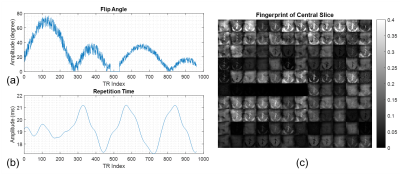 |
3D Inner Volume MR Fingerprinting with Parallel Transmission
Xiaoxuan He1, Naoharu Kobayashi1, Myung Kyun Woo1, Edward J. Auerbach1, Xiaoping Wu1, and Gregory J. Metzger1
1Center for Magnetic Resonance Research, University of Minnesota, Minneapolis, MN, United States
In this simulation study, we explored the feasibility of incorporating parallel transmission to achieve a 3D inner volume MR fingerprinting with an aim to mitigate field inhomogeneities at UHF and reduce field of view (rFOV) for high resolution acquisitions and improved parameter estimation. Our preliminary results showed uniform and consistent contrast within the rFOV. We are currently working on the implementation of the method for further experimental validations.
|
|
3703.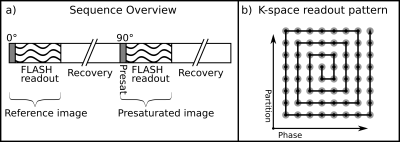 |
Rapid pre-saturated TFL transmit field mapping with an optimized 3D centric single-shot readout
Dario Bosch1, Jonas Bause1, Philipp Ehses2, Moritz Zaiss1,3, and Klaus Scheffler1,4
1High Field Magnetic Resonance Center, Max Planck Institute for Biological Cybernetics, Tuebingen, Germany, 2German Center for Neurodegenerative Diseases, Bonn, Germany, 3Department of Neuroradiology, University Hospital Erlangen, Erlangen, Germany, 4Institute for Biomedical Magnetic Resonance, University Hospital Tuebingen, Tuebingen, Germany
Robust and fast measurements of the transmit field strength is of great importance particularly in parallel transmit applications at ultra-high field. In this work, a pre-saturation TurboFLASH B1+ mapping sequence was optimized for 3-dimensional single-shot acquisition with spiral-centric reordering. Improved SNR and reduced artifacts were achieved by using a variable flip-angle readout. The ability of the proposed sampling scheme to perform fast whole-brain B1+ mapping with low SAR was demonstrated in phantom and in-vivo experiments at 9.4 T. The obtained B1+ maps were comparable to those obtained with the conventional 2D-SatTFL approach but required significantly less scan time.
|
|
3704.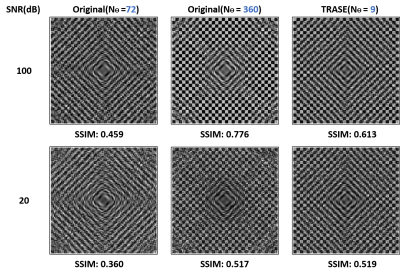 |
TRASE Enforced and Accelerated Nonlinear Spatial Encoding for Low-field Portable MRI and its Local k-space Analysis
GONG JIA1, ZHOU WENSHEN1, YU WENWEI2, and HUANG SHAO YING1
1EPD, Singapore University of Technology, Singapore, Singapore, 2Chiba University, Chiba, Japan
We propose an encoding method which combines Transmit Array Spatial Encoding (TRASE) and spatial encoding magnetic field (SEM) to improve the image quality in a permanent-magnet-array (PMA)-based low-field portable MRI system with acceleration. TRASE is used to introduce phase shift to re-arrange the signal points in local k-spaces, to gain more information quicker to increase imaging quality and speed. A significant quality improvement can be achieved in the reconstructed images, especially in the central regions, which is shown numerically. The number of rotation angles is reduced 80% for the same image quality. The experiments are being conducted for a validation.
|
3705.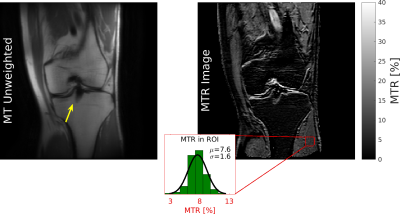 |
Fat Suppressed Magnetization Transfer Contrast Imaging Near Metal
Philip Kenneth Lee1,2, Daehyun Yoon2, and Brian Andrew Hargreaves1,2,3
1Electrical Engineering, Stanford University, Stanford, CA, United States, 2Radiology, Stanford University, Stanford, CA, United States, 3Bioengineering, Stanford University, Stanford, CA, United States
Imaging with fat suppression near metal-induced off-resonance has limited options due to the spectral ambiguity between fat and water. We propose Magnetization Transfer (MT) as an alternative for fat suppressed imaging near metal. We demonstrate that fat suppressed images can be efficiently obtained by modifying slice interleaving of conventional multispectral acquisitions that utilize fast spin echo readouts. These high RF power fast spin echo readouts act as MT preparation pulses for adjacent slices. Furthermore, we show that the image contrast can be predicted by Bloch simulations that incorporate the two-pool model and validate the simulations with in-vivo measurements.
|
|
3706.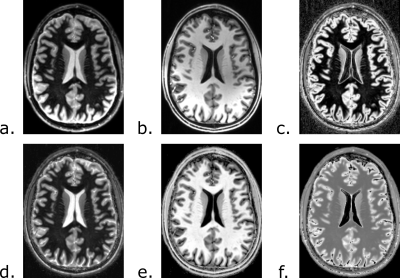 |
High resolution multi T1-weighted contrast with reduced B1 sensitivity using the FLAWS sequence at 7T
Jeremy Beaumont1,2, Giulio Gambarota1, Herve Saint-Jalmes1, Oscar Acosta1, Jean-Christophe Ferré3,4, Parnesh Raniga2, Olivier Salvado5, and Jurgen Fripp2
1Univ Rennes, CRLCC Eugene Marquis, Inserm, LTSI-UMR 1099, F-35000 Rennes, France, 2The Australian e-Health Research Centre, CSIRO, Brisbane, Australia, 3Univ Rennes, Inria, CNRS, Inserm, IRISA, EMPENN ERL U-1228, F-35000 Rennes, France, 4CHU Rennes, Department of Neuroradiology, F35033 Rennes, France, 5Data 61, CSIRO, Brisbane, Australia
Recent studies showed that the FLAWS sequence provides multiple co-registered T1-weighted contrasts of the brain that exhibit reduced B1 sensitivity. In particular, the FLAWS sequence allows for the generation of a standard anatomical contrast, a contrast with WM signal suppression and a GM-specific contrast. This study introduces a combination of FLAWS images to generate a new contrast that may be suitable for the detection of brain lesions at 7T. While the preliminary results of this study are promising, a further validation is required by imaging subjects with lesions and comparing the new FLAWS contrast with other MR sequences.
|
|
3707.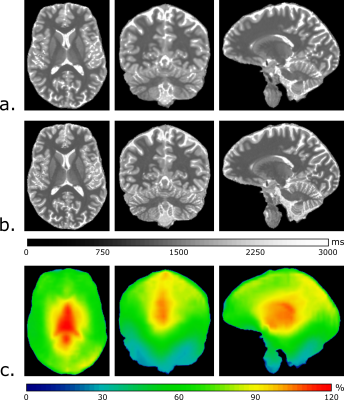 |
High resolution T1 mapping with reduced B1+ sensitivity using the FLAWS sequence at 7T
Jeremy Beaumont1,2, Giulio Gambarota1, Herve Saint-Jalmes1, Oscar Acosta1, Parnesh Raniga2, Olivier Salvado3, and Jurgen Fripp2
1Univ Rennes, CRLCC Eugene Marquis, Inserm, LTSI-UMR 1099, F-35000 Rennes, France, 2The Australian e-Health Research Centre, CSIRO, Brisbane, Australia, 3Data 61, CSIRO, Brisbane, Australia
The MP2RAGE sequence can be used to provide 7T T1-weighted images and T1 maps with reduced transmitted bias field (B1+) sensitivity, at the cost of limiting the image resolution and contrast to noise ratio (CNR). The FLAWS sequence was derived from the MP2RAGE sequence to provide multiple T1-weigthed contrasts that were shown to be of interest for a wide range of clinical applications. The current study shows that the FLAWS sequence can be used to generate 7T T1-weigthed images and T1 maps with reduced B1+ sensitivity, while overcoming the resolution and CNR limitations imposed to the MP2RAGE sequence.
|
|
3708.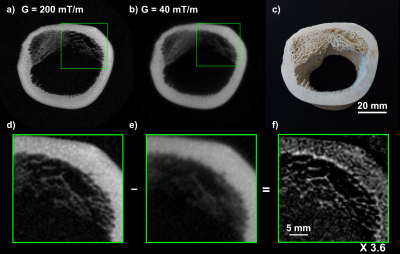 |
Demonstrating the benefits of high gradients in short-T2 MRI
Romain Froidevaux1, Markus Weiger1, Manuela Barbara Rösler1, David Otto Brunner1, Jonas Reber1, and Klaas Paul Pruessmann1
1Institute for Biomedical Engineering, ETH Zurich and University of Zurich, Zurich, Switzerland
Recent developments on high-performance gradients allow MR signals to be encoded much faster than with clinical gradients, hence decreasing T2-related k-space apodization. As a consequence, the point spread function becomes taller and narrower, thus leading to improved actual resolution and higher signal intensity for components with rapid transverse relaxation. In the present work, these benefits are investigated with PSF calculations and demonstrated experimentally using a high-performance gradient. Data of short-T2 tissues (T2 < 1 ms) are acquired using the PETRA technique with different gradient strengths and compared using image subtraction.
|
|
3709.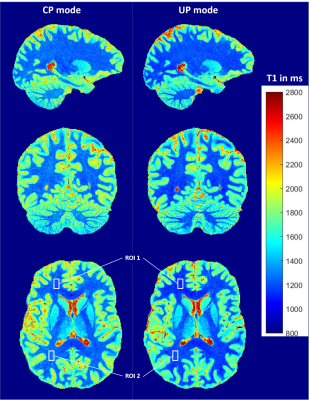 |
PASTeUR package extension with MP2RAGE for robust T1 mapping technique in parallel transmit at 7T
Franck Mauconduit1, Aurélien Massire2, Vincent Gras1, Alexis Amadon1, Alexandre Vignaud1, and Nicolas Boulant1
1DRF/Joliot/Neurospin & Université Paris-Saclay, CEA, Gif-sur-Yvette, France, 2Siemens Healthcare SAS, Saint Denis, France
Universal Pulses (UP) were recently proposed as a plug-and-play pTx solution. To extend the so-called PASTeUR package of anatomical sequences with a mapping technique, we focused on a MP2RAGE acquisition that has shown to be robust against receive profiles when acquired at 7T in single channel transmission. UP provide the advantage of intrinsically correcting for flip angle variations throughout the brain, leading to an increased SNR in regions usually left with low B1+ intensity. Moreover, T1 quantification can be obtained without the need for B1+ acquisition and additional post-processing.
|
|
3710.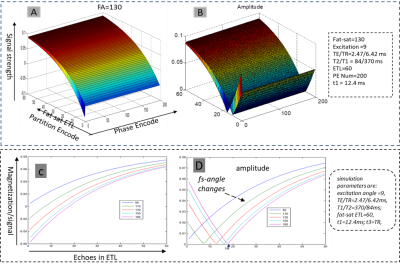 |
A flexible linear reorder scheme for improved fat saturation in 3D VIBE imaging
Qiong Zhang1, Yong Xiao Zhang2, and Yulong Liu3
1DL, Siemens Shenzhen Magnetic Resonance Ltd, Shenzhen, China, 2MR Collaborations, Siemens Healthcare Ltd., Shenzhen, China, 3Beijing Institute of Technology, BeiJing, China
The fast (‘Quick’) fat saturation technique (Q-fat sat) [1], which acquires several k-space lines after each Fat-Sat module, is widely used for suppression of signals from fat in MR imaging. In this work, we developed and evaluated a linear flexible reorder scheme for improved fat saturation VIBE imaging. In vivo experiments indicated that this technique markedly improves suppression of fat saturation signals compared with conventional Q-fat saturation imaging. Studies are underway to validate the clinical value of the technique.
|
|
3711.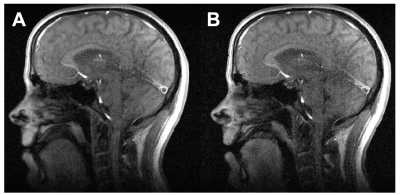 |
Using dielectric bags to increase SNR in dynamic speech imaging
Bradley P. Sutton1,2, Natalie Ramsy3, Riwei Jin1, and Andrew Webb4,5
1Bioengineering, University of Illinois at Urbana-Champaign, Urbana, IL, United States, 2Beckman Institute, University of Illinois at Urbana-Champaign, Urbana, IL, United States, 3Carle-Illinois College of Medicine, University of Illinois at Urbana-Champaign, Urbana, IL, United States, 4Carle Foundation Hospital, Urbana, IL, United States, 5Leiden University, Leiden, Netherlands
Dynamic speech MRI has seen increasing use in the clinic for cleft palate and oral cancer and in research for examining the articulatory patterns of speech. Although potential frame rates have increased, in order to optimize acquisitions, special RF coils may be required to match the anatomy of the population of interest. In this work, we examine the potential of low-cost dielectric pads to significantly improve the SNR of acquisitions using standard head/neck coils. We show a 20% improvement in SNR in speech articulator regions with two dielectric bags placed on either side of the face.
|
|
3712.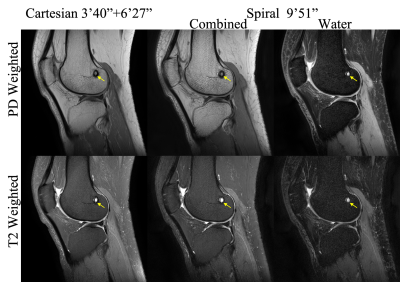 |
Feasibility of High-resolution Knee Imaging with A Spiral Dixon Technique
Dinghui Wang1, Francis I. Baffour1, Zhiqiang Li2, Tzu-Cheng Chao1, Guruprasad Krishnamoorthy3, and James G. Pipe1
1Department of Radiology, Mayo Clinic, Rochester, MN, United States, 2Department of Neuroradiology, Barrow Neurological Institute, Phoenix, AZ, United States, 3Philips Healthcare, Gainesville, FL, United States
In this study, a spiral Dixon technique has been implemented for knee imaging at 3T with high in-plane resolution of up to 0.4 by 0.4 mm2. Volunteer scans have demonstrated that high quality proton density-weighted, T2-weighted and T1-weighted water and fat images can be obtained using spiral spin-echo and dual spin-echo Dixon methods with comparable total scan time as the conventional Cartesian fast (turbo) spin-echo sequences without Dixon. In addition, spiral radial plane imaging can shorten the scan time by 62% compared to the conventional radial plane method.
|
|
3713.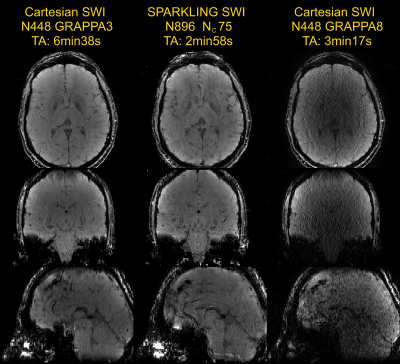 |
Compressed sensing accelerated susceptibility-weighted imaging at 3T with SPARKLING: looking for favorable parametrization
Aurélien Massire1,2, Chaithya G R3, Loubna El Gueddari3, Franck Mauconduit1, Carole Lazarus1, Mathilde Ripart1, Pierre Brugières4, Philippe Ciuciu3, and Alexandre Vignaud1
1CEA\DRF\JOLIOT\NeuroSpin\UNIRS, Gif-sur-Yvette, France, 2Siemens Healthcare SAS, Saint-Denis, France, 3CEA\DRF\JOLIOT\NeuroSpin\PARIETAL, Gif-sur-Yvette, France, 4AP-HP, Hôpital Henri Mondor, Service de Neuroradiologie, Paris, France
Compressed sensing (CS) theory has been successfully employed to drastically reduce MRI acquisition time. Recently, a new optimization-driven algorithm (SPARKLING) was proposed to design optimal non-Cartesian sampling patterns for CS-MRI. This method has several advantages compared to radial or spiral non-Cartesian imaging, yet the question on how the acceleration factor should be selected to ensure satisfactory image quality should be investigated. In this work, we applied the SPARKLING method for 3D susceptibility-weighted imaging, achieving 500μm in-plane resolution and full brain coverage in 3 minutes at 3T (6-fold acceleration compared to fully-sampled Cartesian imaging).
|
|
3714.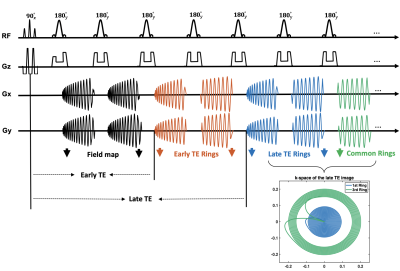 |
SPRING TSE: 2D T2-Weighted Brain Imaging using SPiral RING Turbo Spin-Echo
Zhixing Wang1, Steven Allen1, Xue Feng1, John P. Mugler2, and Craig H. Meyer1
1Biomedical Engineering, University of Virginia, CHARLOTTESVILLE, VA, United States, 2Radiology & Medical Imaging, University of Virginia, CHARLOTTESVILLE, VA, United States
2D Cartesian turbo spin-echo (TSE) is widely used in the clinical neuroimaging, yet the high specific absorption rate (SAR) induced by a large number of refocusing RF pulses limits its use in high magnetic field. Thus, this study describes a new TSE sequence with annular spiral ring acquisitions, dubbed “SPRING TSE”, for fast T2-weigthed imaging and reducing SAR. Preliminary results show that two sets of high spatial resolution images with intermediate and strong T2-weighted contrast characteristics can be obtained by the proposed method within a few seconds.
|
|
3715.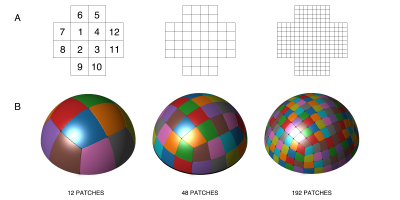 |
3D sector-wise golden-angle (3D-SWIG) – Improved k-space uniformity after ECG binning compared to golden-angle profile ordering
Alexander Fyrdahl1, Joao G Ramos1, Martin Ugander1,2, and Andreas Sigfridsson1
1Department of Clinical Physiology, Karolinska University Hospital and Karolinska Institutet, Stockholm, Sweden, 2The Kolling Institute, Royal North Shore Hospital, and Northern Clinical School, Sydney Medical School, University of Sydney, Sydney, Australia
A radial trajectory with a three-dimensional sector-wise golden-angle (3D-SWIG) profile ordering optimized for retrospective ECG-based binning is presented. Data are acquired in patches using a low-distorting and area-preserving mapping from a cube to a sphere. Within each patch, the readouts are ordered according to the double golden-angle scheme. By acquiring one patch per heartbeat, k-space uniformity is guaranteed even after ECG-binning, resulting in reduced radial streak artifacts.
|
|
3716.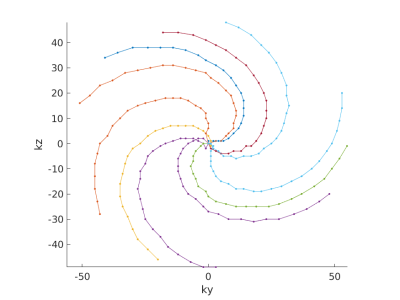 |
4D-EPICS: Compressed Sensing EPI for highly accelerated fMRI at 7T
Thomas Roos1,2, Lukas Gottwald3, Tomas Knapen1,4, Benedikt Poser5, and Wietske van der Zwaag1
1Spinoza Centre for Neuroimaging, Amsterdam, Netherlands, 2Delft University of Technology, Delft, Netherlands, 3Radiology and Nuclear Medicine, Amsterdam UMC, Amsterdam, Netherlands, 4Cognitive Psychology, Vrije Universiteit Amsterdam, Amsterdam, Netherlands, 5Maastricht Brain Imaging Centre, Faculty of Psychology and Neuroscience, Maastricht University, Maastricht, Netherlands
The proposed EPICS readout takes a traditional EPI readout and makes it suitable for Compressed Sensing. This novel readout keeps the EPI direction constant and employs pseudo-spiral under-sampling on a Cartesian grid in the other two (phase encoded) directions. EPICS delivers the flexibility offered by spiral sequences with the relative ease of Cartesian CS reconstruction. Multiple spiral types and patterns with flexible TE's are compared. In-vivo brain image data shows good image quality at 7T. Future 4D-EPICS fMRI acquisitions will be able to profit from regularized CS reconstructions.
|
|
3717.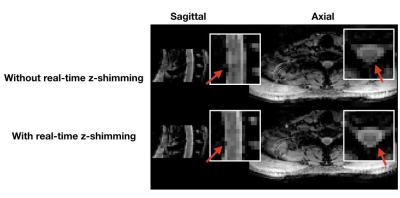 |
Real-Time Z-Shimming for Magnetic Resonance Imaging of the Spinal Cord
Eva Alonso-Ortiz1, Cyril Tous2,3, Ryan Topfer1, and Julien Cohen-Adad1,4
1NeuroPoly Lab, Ecole Polytechnique, Montreal, QC, Canada, 2Department of Radiology, Radiation-Oncology and Nuclear Medicine and Institute of Biomedical Engineering, Université de Montréal, Montreal, QC, Canada, 3Laboratory of Clinical Image Processing Le Centre de Recherche du CHUM, Centre hospitalier de l'Université de Montréal, Montreal, QC, Canada, 4Functional Neuroimaging Unit, Centre de recherche de l'Institut universitaire de gériatrie de Montréal, Montreal, QC, Canada
Spinal cord MRI is notoriously challenging, in part due to the fact the spinal cord is near the lungs, causing magnetic field inhomogeneities that are changing throughout respiration. We propose a novel solution, called real-time z-shimming to address this problem. Real-time z-shimming involves compensating for magnetic field inhomogeneities that arise during image acquisition, by adapting the sequence in real-time. Our findings show that real-time z-shimming can recover signal loss, caused by respiration-induced magnetic field inhomogeneities, in the spinal cord region.
|
|
3718. |
Clinical valid of TOF-MRA with sparse under-sampling in evaluation of intracranial aneurysm: DSA as a reference standard as a reference standard
XU XU1, Zhenlin Li1, and Wanlin Peng1
1Department of Radiology, West China Hospital, Sichuan University, Chengdu, China
When compared with conventional TOF, the sparse TOF which applied compressed sensing to accelerate the acquisition time has been proved to be well-performed in evaluation of UIAs. However, the image quality and the agreement between sparse TOF and DSA need to be studied further. We therefore assessed the clinical validation of sparse TOF compared with conventional TOF in qualitative and quantitative image qualities and explored the correlation among two MRAs and DSA in evaluation of size parameters.
|
|
3719.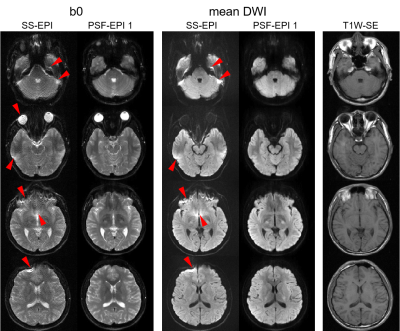 |
Fast Distortion-Free DWI using PSF-EPI on A 1.5T Clinical MRI Scanner with An 8-Channel Head Coil
Simin Liu1, Wenpeng Wu2, Yishi Wang1,3, Jieying Zhang1, Pengcheng Xie2, and Hua Guo1
1Center for Biomedical Imaging Research, Department of Biomedical Engineering, School of Medicine, Tsinghua University, Beijing, China, 2Shenzhen Anke High-tech Co., Ltd., Shenzhen, China, 3Philips Healthcare, Beijing, China
DWI is valuable for diagnosing diseases such as stroke and brain tumor. The traditional single-shot EPI is widely used in DWI because of its high acquisition speed, but it suffers from severe geometric distortions. A recently proposed technique, point-spread-function encoded EPI (PSF-EPI) that is highly accelerated by tilted-CAIPI, can achieve fast distortion-free DWI images on 3T scanners with a 32-channel head coil. This study investigated the feasibility of tilted-CAIPI accelerated PSF-EPI on a 1.5T clinical MRI scanner with an 8-channel head coil. Images with high anatomical fidelity and satisfactory SNR were obtained in 1~2.5 min using this technique.
|
3720.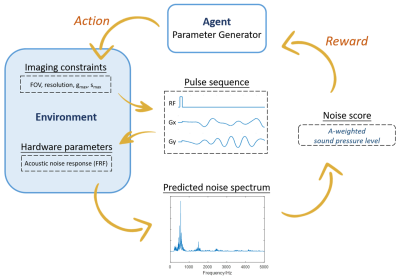 |
Automated k-Space Trajectory Generation using Bayesian Reinforcement Learning for Quiet Single Shot Readout
Zhenliang Lin1, Qikang Li1, Lihong Tang1, Hui Huang1, Junwei Zhao1, and Jie Luo1
1Institute of Medical Imaging Technology, School of Biomedical Engineering, Shanghai Jiao Tong University, Shanghai, China
Acoustic noise during MR scans generated by the gradient coil vibration has been compromising for patient comfort. Single-shot echo planar imaging (EPI), ubiquitously used in functional MRI and diffusion MRI acquisitions, has a rapid switching readout gradient, which is very efficient but also very loud. In this study, we employed a model free reinforcement-learning agent to optimize 2D single shot readout gradient waveforms toward the “reward” of lowering acoustic noise. The preliminary results show that the acoustic noise of the arbitrary trajectory is 17.2 dB lower than EPI for a 2D single slice readout.
|
|
3721.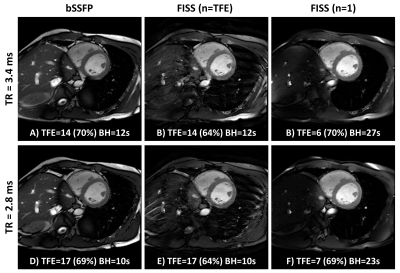 |
Multiband accelerated Fast Interrupted Steady-State (FISS) imaging with 2D Cartesian sampling
Anthony N Price1,2, Lucilio Cordero-Grande1,2, Shaihan J Malik1,2, and Joseph V Hajnal1,2
1Biomedical Engineering Department, School of Biomedical Engineering and Imaging Sciences, King's College London, London, United Kingdom, 2Centre for the Developing Brain, School of Biomedical Engineering and Imaging Sciences, King's College London, London, United Kingdom
In this work we demonstrate the application of Fast Interrupted Stead-State (FISS) imaging with 2D Cartesian sampling and multiband (MB) acceleration to regain scan efficiency. MB-FISS cardiac cine imaging and a free-running sequence for vessel imaging are shown to work reliably with good fat suppression. For cine cardiac imaging FISS with readouts equal to number phase-encode lines in each cardiac segment had minimal scan time increase, while FISS (n=1) lead to breath-hold durations increase ~2.5 fold, but benefit from improved fat suppression and no additional ghosting artefacts compared to bSSFP.
|
|
3722.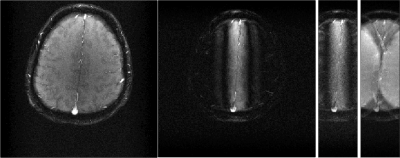 |
Localized imaging using matrix gradient coils
Sebastian Littin1, Feng Jia1, Huijun Yu1, and Maxim Zaitsev1
1Department of Radiology, Medical Physics, University of Freiburg, University Medical Center, Freiburg, Germany
Matrix gradient coils may be used for a non-linear phase preparation to suppress signals in unwanted regions. This allows for a reduction of the FOV smaller than the object without fold-over artifacts and can be seen as a viable alternative to selective excitation.
|
|
3723.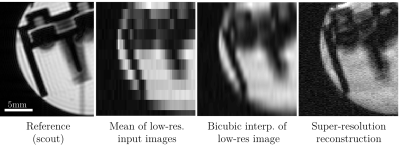 |
Unbalanced SSFP for Ultra-High Field Super-Resolution MRI
Peter J Lally1, Paul M Matthews1,2, and Neal K Bangerter3
1Department of Brain Sciences, Imperial College London, London, United Kingdom, 2UK Dementia Research Institute, London, United Kingdom, 3Department of Bioengineering, Imperial College London, London, United Kingdom
Here we exploit the off-resonance profile of the steady-state free precession (SSFP) sequence to encode spatial information with ultra-low flip angle radiofrequency pulses, enabling a super-resolution reconstruction from a rapid series of low-resolution images. This opens up new possibilities for rapid, high-resolution and low specific absorption rate (SAR) SSFP imaging, particularly at ultra-high magnetic field strengths.
|
|
3724.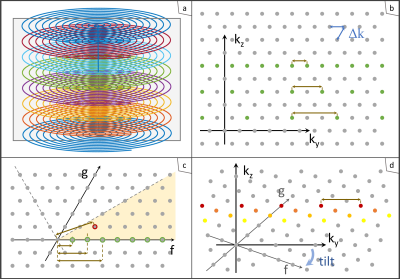 |
Rapid whole-brain imaging with sub-mm resolution using sampling on tilted hexagonal grids (t-Hex)
Maria Engel1, Lars Kasper1, Franz Patzig1, Bertram Wilm1,2, Benjamin Dietrich1, Laetitia Vionnet1, and Klaas Paul Pruessmann1
1Institute for Biomedical Engineering, ETH Zurich and University of Zurich, Zurich, Switzerland, 2Skope Magnetic Resonance Technologies, Zurich, Switzerland
In this work, we show high-resolution stacks of spirals on a tilted hexagonal grid. The new scheme provides flexibility in balancing readout and scan time, thereby allowing for high-quality images in a temporal resolution regime suitable for fMRI. 0.6 mm whole-brain coverage is achieved in below 5.
|
|
3725.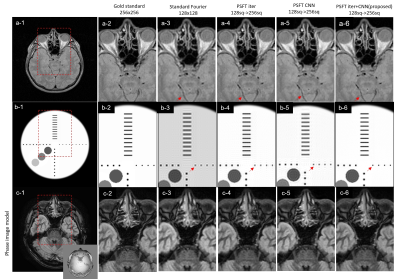 |
Dual Stage Super-Resolution in Quadratic Phase Scrambling Imaging using Iterative Signal Band Expansion and Deep CNN Super-resolution
Satoshi ITO1 and Yasumichi WAKATSUKI1
1Utsunomiya University, Utsunomiya, Japan
Spatial resolution of images in phase scrambling Fourier transform imaging can be improved by post-processing signal band extrapolation. However, the improvements is small in the central area of image space. In our research, super-resolution using deep convolutional neural network are applied to temporally resolution improved images through iterative reconstruction. Simulation and experimental results showed that spatial resolution was fairly improved in the central area as well as in the edge of images. Proposed method is applicable to phase varied images by using adequately estimated phase distribution map since signal under-sampling is not utilized in proposed method.
|
|
3726.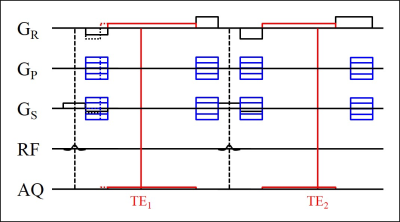 |
Dual-Repetition Gradient-Echo Dixon Imaging with High Signal-to-Noise Ratio Efficiency
Holger Eggers1, Christoph Katemann2, and Hendrik Kooijman2
1Philips Research, Hamburg, Germany, 2Philips Healthcare, Hamburg, Germany
Dual-repetition gradient-echo sequences are currently not widely used for Dixon imaging, because shorter scan times and better signal-to-noise ratios are usually achieved with their dual-echo counterparts. In this work, the efficiency of dual-repetition gradient-echo sequences is optimized by introducing partial echo sampling to extend the acquisition windows and by applying compressed sensing to reduce scan times. On the example of knee imaging, this is shown to enable high-resolution water-fat imaging with good image quality in reasonable scan times.
|
|
3727.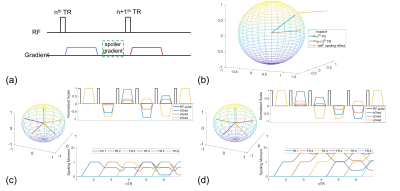 |
Optimizing trajectory ordering for faster small-tip center-out radial gradient echo(GRE)
Xucheng Zhu1,2, Kevin Johnson3,4, and Peder Larson1,2
1Radiology and Biomedical Imaging, University of California, San Francisco, San Francisco, CA, United States, 2UC Berkeley-UCSF Graduate Program in Bioengineering, University of California, San Francisco and University of California, Berkeley, Berkeley, CA, United States, 3Medical Physics, University of Wisconsin, Madison, Madison, WI, United States, 4Radiology, University of Wisconsin, Madison, Madison, WI, United States
Center-out sequence has natural spoiling effect, called “self” spoiling. By leveraging this idea, the standard large spoiler gradient could be reduced or removed without sacrificing the image quality. In this study, we investigated how 3D radial trajectory ordering affects spoiling, and proposed a reordered 2D golden angle scheme to maximize “self” spoiling effect and retain robustness to free breathing scan. We evaluated the proposed ordering scheme on both phantom and volunteer. Proposed scheme without or with small spoiler gradient can reduce up to 40% scan time to get comparable image quality.
|
|
3728.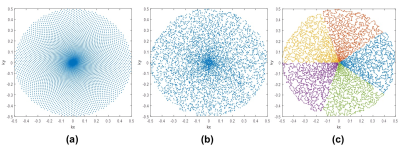 |
Magnetic Resonance Imaging Using Multiple-leaf Smoothed Random-like Trajectory
Haifeng Wang1, Yuchou Chang2, Xin Liu1, Hairong Zheng1, and Dong Liang1
1Shenzhen Institutes of Advanced Technology, Chinese Academy of Sciences, Shenzhen, China, 2University of Houston-Downtown, Houston, TX, United States
Smoothed Random-like Trajectory (SRT) is a promising MR imaging method, but the data acquisitions have some hardware limitations of the gradient amplitude and slew rate. In order to realize the SRT in k-space, we proposed a new multiple-leaf SRT in k-space to reduce hardware requirements for applying the Compressed Sensing (CS) theory. To guarantee the constrains of the gradient amplitude and slew rate and reduce readout, the proposed multiple-leaf gradient waveforms were optimized by the time-optimal method for arbitrary k-space trajectories. The simulations have showed that the proposed method could greatly improve the reconstruction image quality, comparing to spiral trajectories.
|
|
3729.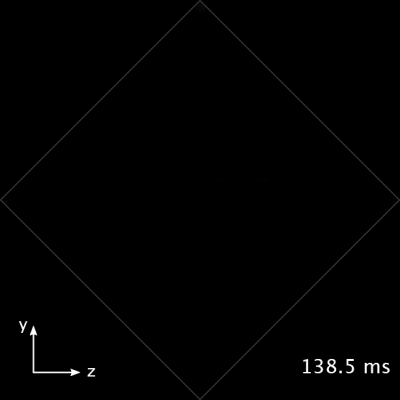 |
Single Point Imaging with Rapid Encoding (SPIRE) for MRI with Sub-millisecond Temporal Resolution
Johannes Fischer1 and Michael Bock1
1Dept. of Radiology, Medical Physics, Medical Center University of Freiburg, Faculty of Medicine, University of Freiburg, Freiburg, Germany
Single Point Imaging with Rapid Encoding (SPIRE) is a new imaging technique for measuring fast and repetitive motion. Here, the temporal resolution does not depend on TR but on the duration of the fast-switching phase encoding gradients. We show the abilities of SPIRE by imaging the falling of water drops and reconstruct the images using self-gating. The obtained image data has a temporal resolution below 0.5 ms and the drops oscillations frequency is measured. The good agreement with predictions shows the accuracy and possibilities of this technique.
|
|
3730.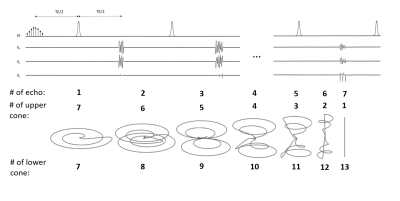 |
A multi echo pulse sequence with optimized excitation pulses and a 3D cone readout for hyperpolarized 13C imaging
Vencel Somai1,2, Alan J Wright1, Maria Fala1, Friederike Hesse1, and Kevin M Brindle1,3
1Cancer Research UK Cambridge Institute, Cambridge, United Kingdom, 2Department of Radiology, University of Cambridge, Cambridge, United Kingdom, 3Department of Biochemistry, University of Cambridge, Cambridge, United Kingdom
We describe here a single shot multi echo sequence for dynamic hyperpolarized 13C imaging with a short readout time, isotropic point spread function (PSF) and high immunity to B0 and B1 field inhomogeneity. The sequence uses numerically optimized excitation pulses and a 3D cone k-space trajectory composed of 13 cones, all fully refocused and distributed among 7 spin echoes. The maximal gradient amplitude and slew-rate were set to 4 G/cm and 20 G/cm/ms respectively to demonstrate the feasibility of clinical translation. The sequence was demonstrated with dynamic imaging of hyperpolarized [1-13pyruvate] and [1-13C]lactate in vivo.
|
|
3731.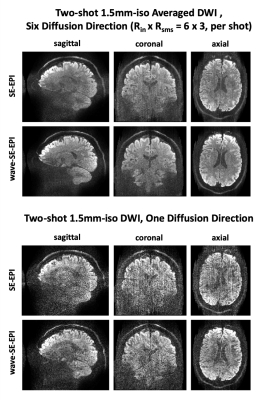 |
Highly Accelerated EPI with Wave Encoding and Multi-shot Simultaneous MultiSlice Imaging
Jaejin Cho1,2, Congyu Liao1,2, Zijing Zhang1,3, Wei-Ching Lo4, Jinmin Xu1,3, Onur Beker1,5, Kawin Setsompop1,2,6, and Berkin Bilgic1,2,6
1Radiology, Athinoula A. Martinos Center for Biomedical Imaging, Charlestown, MA, United States, 2Harvard Medical School, Boston, MA, United States, 3College of Optical Science and Engineering, Zhejiang University, Hangzhou, China, 4Siemens Medical Solution, Boston, MA, United States, 5Electrical and Electronics Engineering, Bogazici University, Istanbul, Turkey, 6Harvard-MIT Division of Health Sciences and Technology, Cambridge, MA, United States
We combine wave controlled aliasing strategy with echo-planar imaging (EPI) and simultaneous multi-slice (SMS) encoding to increase acquisition efficiency and reduce geometric distortion simultaneously for functional (fMRI) and diffusion (dMRI) imaging. Wave-EPI enables RinxRsms=4x3-fold accelerated single-shot gradient-echo (GE)-EPI by reducing the maximum g-factor noise amplification by 2-fold compared to blip-CAIPI. We extend wave-EPI to multi-shot acquisition and incorporate Hankel low-rank constraint to leverage the similarities among the shots for improved reconstruction. This allows us to create a 10-second structural scan with 12-fold reduced distortion and push the acceleration rate to RinxRsms=6x3-fold in dMRI using 3-shots with markedly improved image quality.
|
|
3732.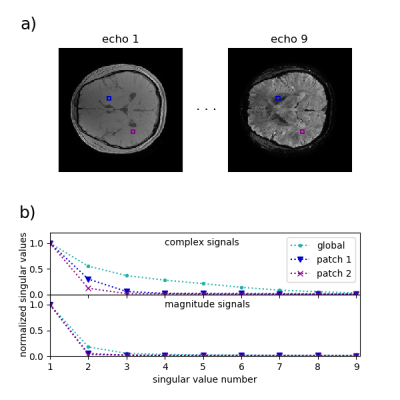 |
Accelerated Multi-Echo Gradient Echo Imaging using Locally-Low Rank Regularization
Mirco Grosser1,2 and Tobias Knopp1,2
1Section for Biomedical Imaging, University Medical Center Hamburg-Eppendorf, Hamburg, Germany, 2Institute for Biomedical Imaging, Technical University Hamburg, Hamburg, Germany
Reconstruction methods for multi-contrast MRI often employ a low-rank constraint to reconstruct images from highly undersampled data. For multi-echo gradient echo sequences such a constraint is hard to impose due off-resonance-induced oscillations of the time signals. In this work we show that spatio-temporal correlations can be exploited efficiently using locally low rank regularization. Based on this observation we develop a locally-low rank regularized reconstruction scheme and test it on a multi-echo gradient echo dataset of a human brain. In our tests the proposed method shows significantly improved image quality compared to regular compressed sensing reconstructions.
|
|
3733.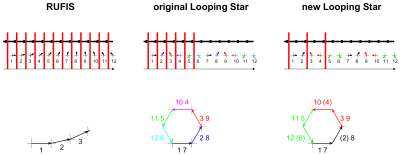 |
Looping Star: Revisiting echo in/out separation
Florian Wiesinger1,2 and Ana Beatriz Solana1
1GE Healthcare, Munich, Germany, 2King's College London, London, United Kingdom
Recently, we introduced a new MR pulse sequence, termed Looping Star, for fast and yet quiet 3D radial, multi-gradient echo MR imaging. The method is based on the 3D radial Rotating Ultra-Fast Imaging Sequence (RUFIS, aka Zero TE) extended by a time-multiplexed gradient refocusing mechanism; providing an initial free-induction-decay (FID) image followed by equidistant gradient echo (GRE) images. In its original implementation, the method was affected by overlapping echo in/out signals. Here we present a solution to this problem, allowing faster scanning and/or higher resolution.
|
|
3734.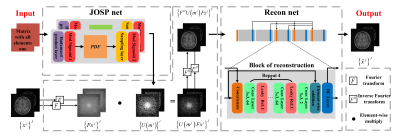 |
Joint optimization of sampling patterns and reconstruction for multi-contrast fast magnetic resonance imaging
Jiechao Wang1, Qinqin Yang1, Qizhi Yang1, Shuhui Cai1, and Congbo Cai1
1Department of Electronic Science, Xiamen University, Xiamen, China
Multi-contrast magnetic resonance imaging (MRI) is usually required in clinical diagnosis but different contrast MRI may need different scan time. To balance total scan time and reconstruction fidelity, the recovery of multi-contrast MR images relies on the collaborative acquisition of sampling patterns and reconstruction algorithm. We proposed a novel neural network that could jointly optimize sampling patterns and concurrently reconstruct multi-contrast MR images. The reconstructed multi-contrast MR images using optimized sampling patterns on a two-contrast dataset demonstrate that the average peak signal-to-noise ratio and structural similarity among contrasts improve obviously compared with reconstructed results using fixed and independent sampling patterns.
|
|
3735.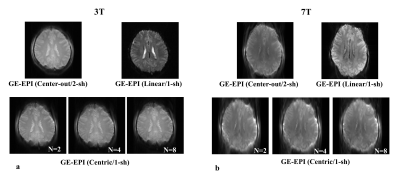 |
Single-shot Pseudo-Centric EPI for Magnetization-Prepared Imaging
Hyun-Soo Lee1, Seon-ha Hwang1, Jaeseok Park2, and Sung-Hong Park1
1Department of Bio and Brain Engineering, KAIST, Daejeon, Korea, Republic of, 2Department of Biomedical Engineering, Sungkyunkwan University, Suwon, Korea, Republic of
Single-shot EPI is a famous ultra-fast MR imaging technique, but is limited to linear reordering due to its special k-space trajectory. In this study, we proposed a single-shot pseudo-centric EPI where k-space is encoded from center to periphery in a groupwise manner by utilizing grouped oscillating readout gradients, phase‑encoding blips within each group, and big phase‑encoding jumps between two consecutive groups. The concept was tested on phantoms and human brains in 3T and 7T. The proposed method enabled the significant reduction of TE, which is expected to maximize SNR of magnetization-prepared imaging and enable ultrashort-TE imaging in the Cartesian coordinate.
|

 Back to Program-at-a-Glance
Back to Program-at-a-Glance View the Poster
View the Poster Watch the Video
Watch the Video Back to Top
Back to Top